Explore Yala National Park - Sri Lanka Travel, Asia
Tucked away in Sri Lanka’s southeastern corner, Yala National Park is where wild nature meets deep tradition. Known worldwide for its leopard population, the park is also home to elephants, sloth bears, crocodiles, and hundreds of bird species. Beyond wildlife, Yala opens doors to a cultural landscape dotted with ancient temples, Buddhist ruins, and coastal villages. For travelers seeking more than just a safari, Yala offers a chance to explore eco-tourism, local communities, and sacred heritage sites.
Population: The Yala National Park area doesn’t have a human population.
Economy: The economy around Yala National Park thrives on a blend of eco-tourism, agriculture, and local services. Safari tours, eco-lodges, and cultural experiences drive steady income for nearby towns like Tissamaharama and Kataragama, supporting thousands of families.
Landmarks: Famous for Block I of Yala and wildlife encounters, including elephants, sloth bears, crocodiles, and exotic bird species.
Sri Lanka
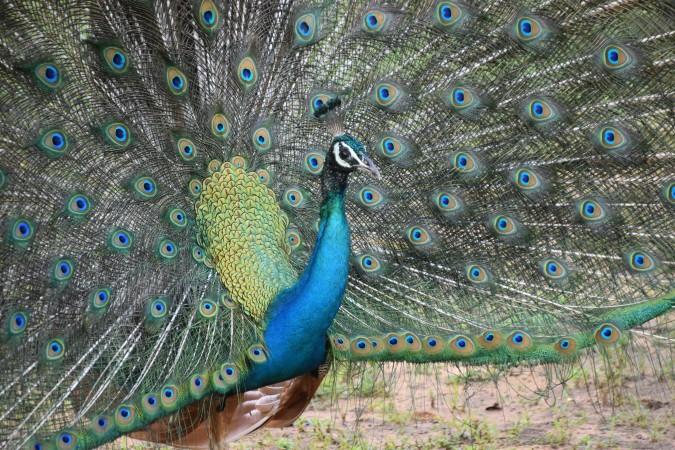
Overview of Yala National Park
History & Cultural Influence
Yala is not only a sanctuary for wildlife but also a land of history and spirituality. Archaeological findings reveal that the region has been a Buddhist monastic settlement for centuries. Sites such as the Sithulpawwa Rock Temple, once home to thousands of monks, remind visitors of its religious importance. Carved stone pillars, moonstones, and ruins of ancient reservoirs scattered across the park reflect a rich heritage connected to the Anuradhapura and Ruhuna kingdoms.
During the colonial period, Yala was marked out as a game reserve. Over time, this status evolved into a protected national park, balancing conservation with responsible tourism. Today, Yala embodies both cultural resilience and ecological preservation, making it a unique travel destination where history breathes alongside the calls of the wild.
Interaction with The Locals
The gateway towns of Tissamaharama, Kirinda, and Kataragama thrive on their proximity to Yala. Visitors will quickly notice the warmth and hospitality of the people. Local guides, safari drivers, and lodge owners are eager to share their stories, often passed down through generations living close to the forest.
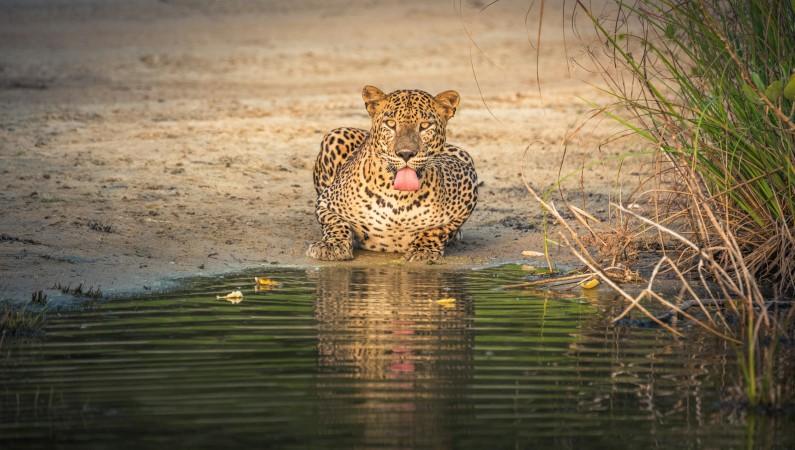
Top Attractions in Yala National Park
- Leopard Sightings: Yala is world-famous as a leopard hotspot, with a chance to see these elusive big cats basking on rocks or prowling at dawn and dusk.
- Elephants and Other Wildlife: Herds of Asian elephants, playful sloth bears, spotted deer, and mugger crocodiles thrive here. Over 200 bird species make the park a paradise for birdwatchers, especially during the migratory season.
- Sithulpawwa Rock Temple: This ancient Buddhist site rises above the jungle canopy. Pilgrims and travelers alike climb the rock for panoramic views while exploring monastic caves and centuries-old frescoes.
- Magul Maha Viharaya: Another historic treasure within the park, said to be the site of a royal wedding during the Ruhuna kingdom. Its stone ruins whisper tales of ancient Sri Lankan civilization.
- Untamed Landscapes: Beyond wildlife, Yala’s charm lies in its diverse habitats: golden beaches, coastal lagoons, scrublands, and thick forests. These natural contrasts make every safari ride a changing canvas.
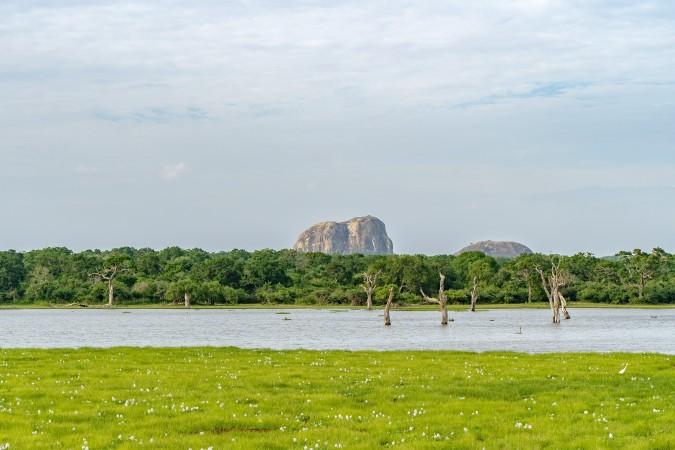
Must-Try Dishes in Yala
- Kiribath (Milk Rice): A ceremonial dish often served during festivals. Creamy rice cooked in coconut milk, usually enjoyed with spicy sambols.
- Fish Ambul Thiyal: A sour fish curry made with local tuna, tamarind (goraka), and spices. A southern specialty that pairs perfectly with steamed rice.
- Pol Sambol: A fiery coconut relish mixed with chili, lime, and onion. This staple is served at almost every meal.
- Hoppers (Appa): Bowl-shaped pancakes made from fermented rice flour and coconut milk. Best eaten with dhal curry or a fried egg.
- String Hoppers (Idiyappam): Steamed rice noodle nests, often served with coconut milk gravy and spicy curries.
- Fresh Seafood from Kirinda: Grilled prawns, crab curry, and lagoon fish highlight the coastal bounty near Yala.

Festivals & Local Celebrations
- Kataragama Festival (Esala Perahera): Held each July or August in Kataragama, this colorful event is one of the country’s most sacred pilgrimages. Devotees from across Sri Lanka gather to honor Lord Kataragama through fire-walking, kavadi dances, drumming, and grand processions. Travelers are welcome to watch respectfully, making it an unforgettable cultural experience.
- Sinhala and Tamil New Year (Avurudu): Celebrated in April, this festival marks the harvest and the astrological new year. Families prepare traditional sweets, light firecrackers, and play folk games. Visitors staying near Tissamaharama can join locals in the festivities.
- Poya Days: Each full moon day in Sri Lanka is a religious observance. Temples near Yala, such as Sithulpawwa, fill with pilgrims dressed in white, chanting and offering flowers. These days provide a peaceful cultural experience for travelers seeking spiritual insight.
- Village Fairs and Harvest Celebrations: In smaller communities around the park, travelers may stumble upon fairs with folk music, traditional dance, and local handicrafts. These gatherings reflect the close ties between people, land, and tradition.

What to Do in Yala National Park
- Jeep Safaris: The highlight of any visit. Safaris typically begin at dawn or late afternoon, offering the best chance to spot leopards, elephants, and flocks of migratory birds. Experienced guides share knowledge about the park’s flora and fauna.
- Birdwatching Tours: With more than 200 species recorded, including painted storks, crested serpent eagles, and migratory flamingos, Yala is a paradise for bird lovers.
- Camping and Eco-Lodges: For a closer connection with nature, travelers can stay in eco-camps set on the edge of the park. Nights under the stars are often accompanied by the distant calls of wildlife.
- Cultural Trails: Visits to Sithulpawwa Rock Temple and nearby archaeological sites combine history with exploration. These trails link Yala’s natural wonders with its ancient spiritual identity.
- Coastal Adventures: Beyond the forest, Yala opens to unspoiled beaches near Kirinda and Bundala, where travelers can relax or take short boat trips.
Shopping in Yala
- Handmade Batik Textiles: Brightly patterned fabrics showcasing Sri Lanka’s artistry.
- Wood Carvings and Masks: Crafted from local timber, often inspired by wildlife or traditional ritual designs.
- Jewelry and Beads: Simple yet elegant creations made by local artisans, sometimes using semi-precious stones.
- Spices and Ceylon Tea: Sold at village markets and small shops, ideal for travelers who want to bring home the taste of Sri Lanka.
- Village Markets: Lively spaces where visitors can browse fruits, vegetables, handwoven baskets, and daily essentials alongside locals.
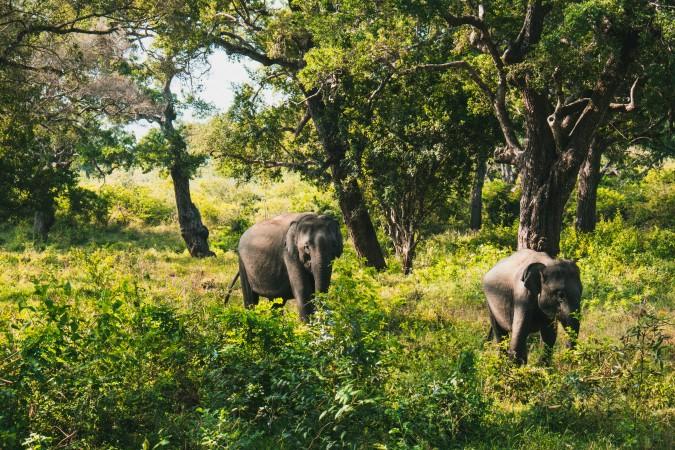
Weather in Yala National Park: Best Time to Visit
- Dry Season (February – July): The most popular time for safaris. Water sources shrink, drawing animals closer to lakes and waterholes. This increases the chance of spotting leopards, elephants, and herds of deer. Daytime temperatures average 28–30°C (82–86°F), making early mornings and evenings the most comfortable times for outdoor activities.
- Rainy Season (September – December): Yala receives monsoon rains, transforming the park into a lush green landscape. Although some areas may close due to flooding, this is the best time for birdwatching as migratory species arrive.
- Transitional Months (January & August): Weather can be mixed, but safaris are still possible. Fewer crowds make this an appealing time for travelers seeking a quieter experience.
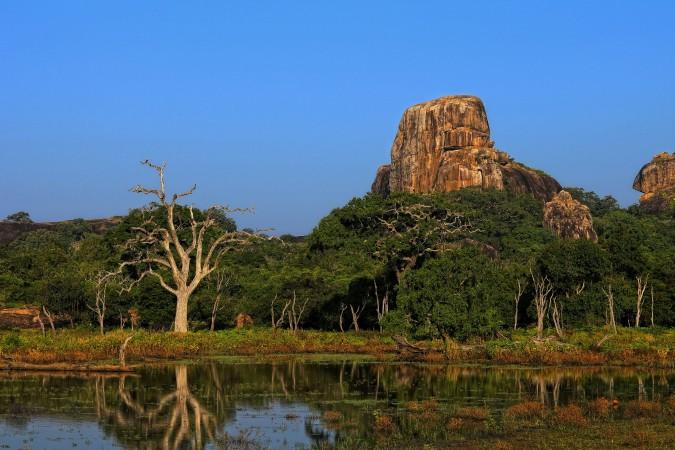
Essential Travel Information
Getting Around Yala National Park
- By Road: Private taxis, rental cars, and intercity buses are the most common options. A drive from Colombo takes about 5–6 hours, while from Galle it’s around 4 hours.
- By Train: Trains do not run directly to Yala, but travelers can ride to Matara or Hambantota and continue by road.
- Local Transport: Tuk-tuks and hired vans are widely available in Tissamaharama and Kataragama for short distances.
- Safari Jeeps: Inside the park, specially licensed jeeps with experienced guides are the only way to explore. Safaris are usually booked through hotels, tour operators, or directly at the park entrance.
- Air Travel: Domestic flights to Mattala Rajapaksa International Airport provide quicker access for travelers with limited time.
ATM & Banking Services
The closest ATMs are in Tissamaharama, Kataragama, and Hambantota. Major banks such as Commercial Bank, People’s Bank, and Bank of Ceylon operate branches here. Larger hotels, eco-lodges, and safari operators often accept credit and debit cards. However, smaller guesthouses, tuk-tuk drivers, and local eateries prefer cash.
Travel Tip: Always withdraw enough cash before heading into the park, as there are no ATMs inside Yala itself. Keeping small denominations makes paying for tips, snacks, and market purchases easier.
Where to Stay in Yala National Park
- Luxury Safari Lodges: Nestled on the park’s edge, these resorts combine modern amenities with wilderness settings. Expect private safari tours, infinity pools, and fine dining.
- Eco-Lodges and Tented Camps: Perfect for travelers who want to immerse themselves in nature while maintaining comfort. Nights under canvas bring the sounds of the jungle right to your doorstep.
- Mid-Range Hotels: Located in Tissamaharama and Kataragama, these provide comfort at reasonable rates, with easy access to safari operators.
- Family-Friendly Resorts: Properties offering larger rooms, pools, and activities for children, making them convenient for families traveling with kids.
Des articles pour vous

Explore Yala National Park - Sri Lanka Travel, Asia
Tucked away in Sri Lanka’s southeastern corner, Yala National Park is where wild nature meets deep tradition. Known worldwide for its leopard population, the park is also home to elephants, sloth bears, crocodiles, and hundreds of bird species. Beyond wildlife, Yala opens doors to a cultural landscape dotted with ancient temples, Buddhist ruins, and coastal villages. For travelers seeking more than just a safari, Yala offers a chance to explore eco-tourism, local communities, and sacred heritage sites.
Population: The Yala National Park area doesn’t have a human population.
Economy: The economy around Yala National Park thrives on a blend of eco-tourism, agriculture, and local services. Safari tours, eco-lodges, and cultural experiences drive steady income for nearby towns like Tissamaharama and Kataragama, supporting thousands of families.
Landmarks: Famous for Block I of Yala and wildlife encounters, including elephants, sloth bears, crocodiles, and exotic bird species.

Explore Galle - Sri Lanka Travel, Asia
Nestled on Sri Lanka’s southern coastline, Galle is a vibrant city where history meets the sea. Its cobbled streets, colonial architecture, and serene beaches make it a must-visit destination for travelers seeking a blend of culture, adventure, and relaxation. A UNESCO World Heritage site, Galle captivates visitors with its Dutch Fort, bustling markets, and friendly locals. Whether you’re exploring the ramparts at sunset or savoring fresh seafood by the shore, Galle promises an unforgettable journey into Sri Lanka’s heritage.
Population: Approximately 113,000 in 2023.
Economy: Galle’s economy thrives on tourism, trade, and fisheries. The city’s historic fort, colonial architecture, and coastal charm draw thousands of international visitors each year, making tourism its main economic driver. Fishing remains vital for local livelihoods, supplying fresh seafood across the region.
Landmarks: Famous for the Galle Fort, Dutch Reformed Church & Maritime Museum, and Unawatuna Beach.

Explore Bentota - Sri Lanka Travel, Asia
Nestled along Sri Lanka’s southwestern coast, Bentota is a tropical paradise that blends golden beaches, vibrant culture, and thrilling adventures. Famous for its calm waters, luxury resorts, and scenic river estuary, Bentota has become a top destination for travelers seeking both relaxation and authentic experiences. From serene beach walks at sunrise to adrenaline-pumping water sports, this coastal town offers a perfect balance of leisure and exploration. With its proximity to Colombo and Galle, Bentota is easy to reach, making it an ideal stop for both short escapes and extended holidays.
Population: Approximately 37,000 in 2023.
Economy: Bentota’s economy thrives mainly on tourism, which drives local businesses such as hotels, restaurants, and wellness retreats. The town also benefits from fishing, coconut cultivation, and handicrafts like wood carving and batik textiles. Many residents rely on the growing demand for water sports and Ayurvedic treatments, making tourism the backbone of both income and employment in the area.
Landmarks: Famous for Bentota Beach, Bentota River Safari, and Kande Vihara Temple.

Explore Mirissa - Sri Lanka Travel, Asia
Mirissa is a charming coastal town on Sri Lanka’s southern shoreline. Known for its golden beaches, turquoise waters, and vibrant marine life, it has become a must-visit stop for travelers exploring the island. Many come for whale watching, surfing, and sunset views at Coconut Tree Hill, but Mirissa offers much more than postcard beauty. The fishing boats you see anchored by the bay carry generations of stories. Local traditions, delicious cuisine, and a laid-back rhythm of life shape every visitor’s experience.
Population: Approximately 4,700 in 2023.
Economy: Mirissa’s economy is largely shaped by its coastal location. Fishing has long been the backbone of local livelihoods, with generations relying on the Indian Ocean for income. In recent decades, tourism has become the main driver of growth, thanks to whale watching, surfing, and beachside hospitality.
Landmarks: Famous for Mirissa Beach, Coconut Tree Hill, and Parrot Rock Bridge.

Explore Nuwara Eliya - Sri Lanka Travel, Asia
Tucked away in the Central Highlands of Sri Lanka, Nuwara Eliya is often called “Little England”. With its rolling tea plantations, cool misty mornings, and colonial charm, this mountain town feels like a step into another world. Travelers come here to breathe fresh air, walk through flower gardens, sip the finest Ceylon Tea, and enjoy a pace of life far from the island’s busy cities. Whether you’re drawn by scenic landscapes, heritage architecture, or the warmth of its people, Nuwara Eliya is a destination that blends nature, culture, and history in perfect harmony.
Population: Approximately 781,000 in 2023.
Economy: Nuwara Eliya’s economy thrives mainly on tea production, as it sits in the heart of Sri Lanka’s central highlands, famous worldwide for Ceylon Tea. The city also benefits from a growing tourism industry, attracting visitors with its colonial charm, cool climate, and scenic landscapes.
Landmarks: Famous for Gregory Lake, Hakgala Botanical Garden, and Victoria Park.

Explore Sukau - Malaysia Travel, Asia
Nestled on the banks of the Kinabatangan River in Sabah, Malaysian Borneo, Sukau is a destination where wildlife, culture, and conservation come together. Known as one of Asia’s top spots for river safaris and eco-tourism, this quiet village offers a front-row seat to encounters with Bornean orangutans, pygmy elephants, proboscis monkeys, and exotic birdlife.
Population: Approximately 1,400 in 2019.
Economy: Sukau’s economy is shaped by its riverine location and natural resources. Traditionally, the Orang Sungai community relied on fishing, small-scale farming, and forest gathering for their livelihood. Today, the village has shifted toward eco-tourism, with river cruises, jungle trekking, and homestays providing income.
Landmarks: Famous for the Kinabatangan River cruises, Gomantong Caves, and Ox-bow lakes and wetlands.
